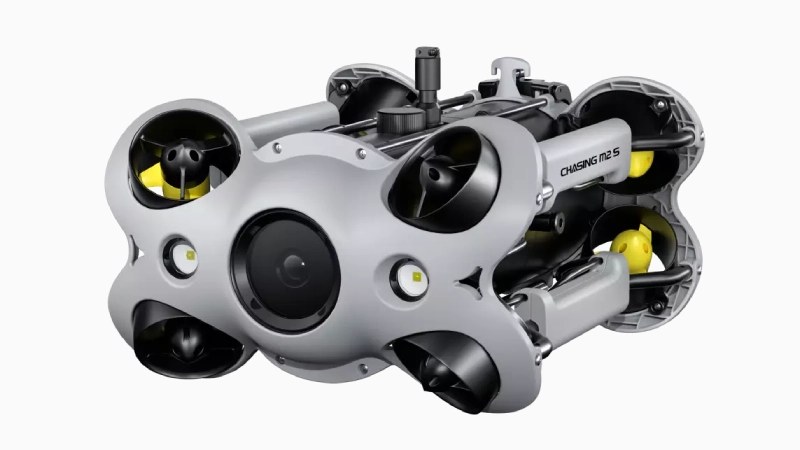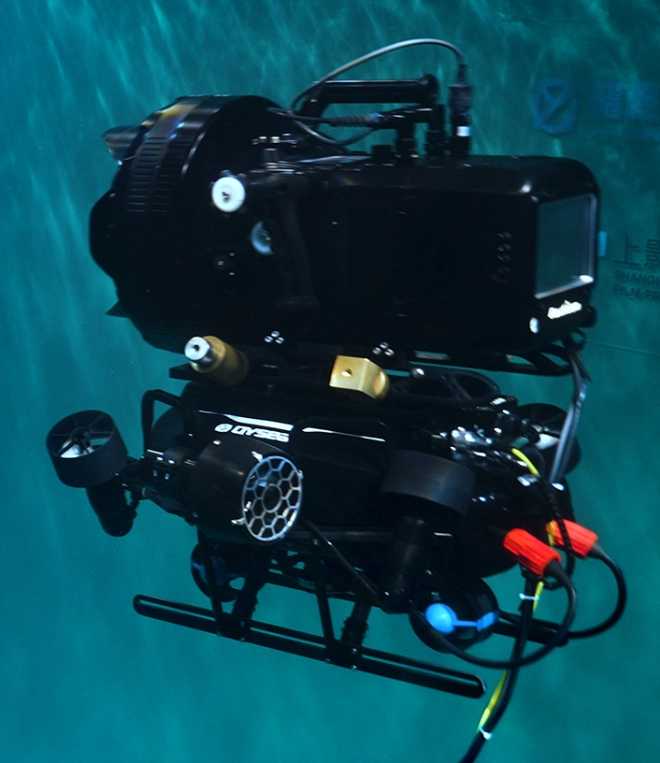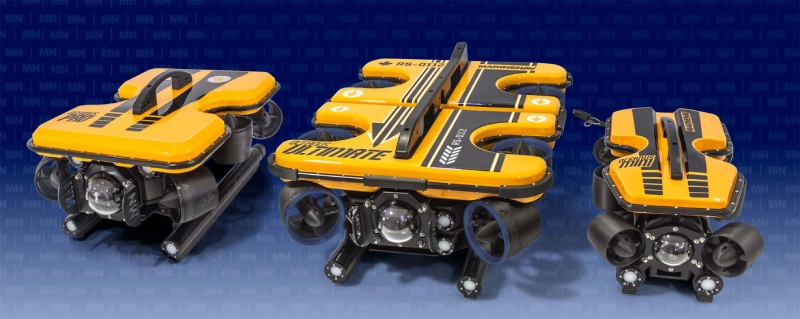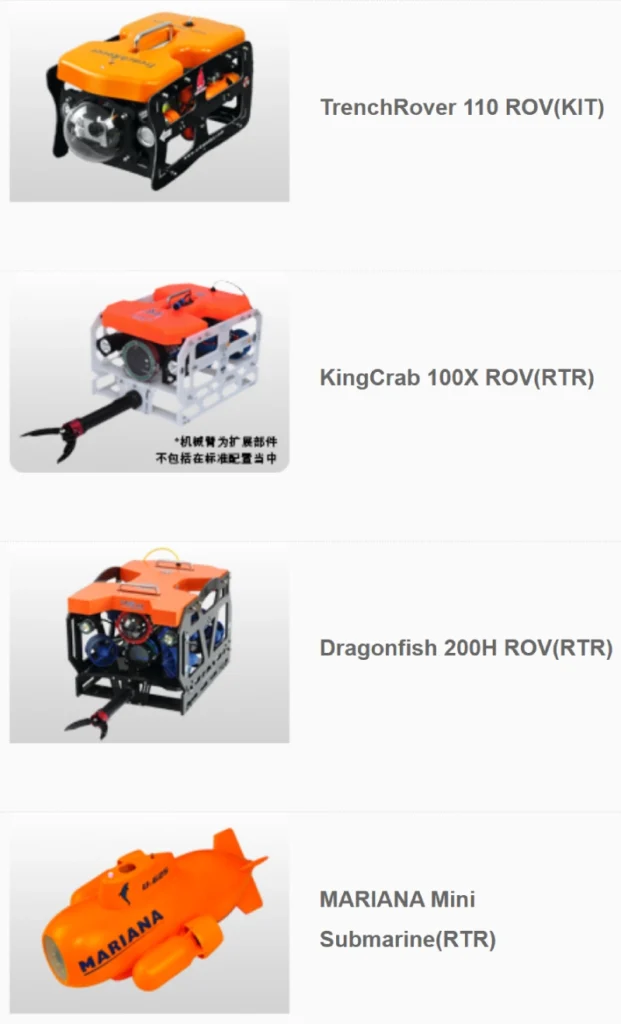Table of Contents
Highlights
- Cutting-Edge Imaging & Lighting – Advanced sonar, 360° cameras, and high-lumen LEDs enable underwater drones to see clearly in murky water, even in low-visibility conditions.
- Durability & Remote Control – Built with rugged materials, thrusters, and remote operability for safe, efficient navigation in harsh underwater environments.
- Diverse Industry Applications – From marine biology and aquaculture to defense and infrastructure inspection, these underwater drones for murky water serve professionals and hobbyists alike.
Whether installing subsurface cables for energy infrastructure or observing aquatic life for conservation purposes, many industries require observational drones. The technologies continually improve, but many organizations require machinery capable of navigating places where it would otherwise be difficult to see. Discover the best underwater drones for murky water and what makes them effective.
What Makes a Drone Adept at Navigating Murky Water?
These are the criteria that mark quality equipment when evaluating a company’s drones and inform the methodology behind highlighting these choices.
Multiple Imaging Technologies
To navigate through fog, drones require multiple imaging capabilities to create comprehensive images of their path. These include sound pulses and high-frequency beam scanners, among others. The most advanced equipment can design a 360-degree picture of its surroundings by leveraging all of these tools. This is crucial for seeing potential threats from behind the device or navigating spaces with limited mobility.
Remote Operability and Maintenance
Some drones remain underwater for a long time, meaning experts need to change their mission’s course or understand their health from a distance. The controls should permit smooth maneuverability without lag and features, such as thrusters, which can propel it out of tight situations without requiring human intervention.
Additionally, internal systems should notify operators when the drone experiences damage. Some components should be able to receive temporary remote maintenance, such as software updates, to ensure optimal performance. This keeps the drone operational for longer and prevents downtime.
Finally, it must have robust ultra-short baseline (USBL) systems. These enable acoustic positioning. Operators need to know the location of their equipment, even when GPS and other mapping systems are unavailable.
Advanced Lighting Systems
While imaging is essential, lighting is equally vital. It should have energy-efficient bulbs that can remain on for extended periods, such as LEDs. The beams should be able to pierce through any murkiness, fog, pollution, and other influences easily, helping visual technologies create crisp images. It also helps operators understand what is happening in real-time, allowing for live observations and inspections of the environment and nearby specimens.
Material Durability
The environmental stressors of deep waters can damage fragile equipment. A drone will encounter intense pressure, extreme temperatures, and high turbidity. It may also encounter acidic conditions or masses of debris it has to weave through. The drone must be able to withstand and navigate situations where it might be compromised.
Serviceability and Customer Support
The underwater drone space is constantly evolving, sometimes rendering models obsolete as new cameras and location functions make prior equipment outdated. However, the best organizations continue to provide expert customer service for the entire range, including machinery that is several years old. A willingness to issue repairs, offer warranties, and provide advice on how to maintain these machines is essential for building customer trust.
1. Deep Trekker

Deep Trekker has designed one of the most proficient yet affordable ROVs on the market. The machine was built by a passionate founder and team who wanted to expand the world’s understanding of the ocean’s shipwrecks and other mysteries. Underwater drones like DTG2 are surrounded by durable cast aluminum, making them rugged and secure in harsh conditions. The team has helped industries from fisheries to archaeologists.
Its quality control protocols, with its in-house pressure tanks, are among the most stringent in the market, which is why it can support the most critical industries, such as military and research. Deep Trekker is also willing to expand its customer base, as evidenced by the creation of the DT340 pipe crawler, designed to assist those in the sewage sector. It saw an opportunity to help others and took it. Alongside advanced ROV GPS, 4K cameras with optimization features, long tether lengths, and rotational cameras and sonars, these functions prove why it is one of the best underwater drones for murky water.
2. Chasing Innovation

Chasing Innovation promises to help everyone explore the unexplored with its industrial-grade ROVs. It has reached 100 countries, built 12 unique ROVs, and patented over 300 inventions. Its designs are perfect for deep, dense waters. Chasing has helped hull inspectors and emergency rescue teams alike, demonstrating the quality of their products, to the extent that industries can trust them with a keen eye and high compliance requirements. Its tech is also usable by consumers without sacrificing quality.
The Chasing X is omnidirectional and anti-current, making it easy to position, even in rough terrain. Another option is the Chasing M2 Pro Max, which has 8,000 lumen floodlights and 360-degree motion. Divers can add five accessories to it, enhancing its visibility even further in foggy water. The designs are user-friendly, allowing anyone to find a way to leverage their potential.
3. QYSEA

QYSEA was founded in China in 2016, and it is most known for its FIFISH series of underwater drones. Its unique value proposition is its artificial intelligence (AI) integrations. While others in the market may be weaving this into upcoming technologies, QYSEA has it as an established feature with more years of experience with it than its competitors. Its machines have been used across industries, including filmmaking, which needs drones able to capture crystal-clear visuals to create artful masterpieces.
Its main models include the V6, V-EVO, E-Master, and W6. Across these drones, buyers will find 360-degree movement, 4K UHD cameras, AI vision, virtual reality (VR) controls, and more. One of the most satisfying features is its AI-powered diver tracking, which can also monitor groups of machines. Use these underwater drones for surveying or carrying flexible payloads at depths of hundreds of meters.
4. VideoRay

VideoRay is based in Pennsylvania and has been established since 1999. It is one of the most experienced companies in the underwater drone market. Its specialty lies in micro-ROVs for security and inspection applications. Smaller drones need advanced visual capabilities, especially if they are navigating hard-to-reach spaces with low light and murkiness. The team also promises serviceability for a decade after purchase.
Its primary products include the Pro 4, Defender, and Mission Specialist drones. VideoRay also offers training to professionals seeking to level up their expertise in drone usage. With its years of experience, it is one of the best training resources consumers can get their hands on. This ensures high-stakes industries, like critical infrastructure, can use the machinery in the most effective way.
5. MarineNav

MarineNav is a drone maker based in Canada with over 15 years of experience. Its expertise covers more than underwater drones – the team also works in marine-grade computers and fleet management software. This additional insight helps make their ROVs some of the most advanced. It is registered with the Controlled Goods Program and ISO 9001, ensuring customers that the products comply with regulations and meet the highest standards. Despite this, the products remain highly customizable.
The company is renowned for its exceptional customer support. The product team is dedicated to hearing what users have to say about design and construction, so they can continue to create better models in the future. It faces tech issues with some of the fastest resolution times in the space, which is reinforced by extensive warranties and a Peace of Mind guarantee. Customers can view their product line in the finest detail, including their Oceanus Mini-Lite ROV, which is highly portable with an anodized metal chassis.
6. Aquarobotman

Aquarobotman is one of the most recent organizations on this list, but its products are meeting the standards of a large market. Its machines are best suited for budding professionals due to their affordability, although industry-grade operations are still viable. However, they still have an extensive line of underwater rescue equipment and unmanned systems. It prides itself on having an extensive research and development team that continually delivers the best integrated solutions to customers.
Its best-known models include underwater drones like the Nemo and MagicJet. These drones have 4K cameras, VR support, and modular batteries. It also stocks products to help with smart fishing operations, like intelligent drainage and feeding peripherals. This demonstrates a willingness to facilitate more niche tasks in targeted industries, which can only make the drone’s insights more valuable.
7. THOR Robotics

Thor Robotics, based in China, designs and manufactures professional-grade ROVs, as well as a variety of underwater machinery, including multivector robots and vehicle control systems. It is known for its international presence and dedicated research team. The team has helped water rescue missions, maritime experts, and more.
Its main machines include the TrenchRover, KingCrab, Dragonfish, and MARIANA Mini Submarine. These ROVs give operators advanced visibility with high-lumen LEDs and additional searchlights. Some models, such as the Dragonfish, feature HD 1080P cameras and offer extended battery life for deeper dives. Most of the drones have other crucial features, like leak-detection sensors, precise electronic compasses, lightweight bodies, and automated orientation functions.
Comparing Underwater Drones
Make informed decisions about drone purchases by evaluating each company based on its years of experience, unique offerings, and target market.
| Company | Founded | Unique Value Proposition | Target Industry |
| Deep Trekker | 2010 | Portability and environmental resistance | Industrial |
| Chasing Innovation | 2016 | Industrial-grade machines | Industrial and consumer |
| QYSEA | 2016 | AI-powered capabilities | Industrial |
| VideoRay | 1999 | Security | Critical infrastructure |
| MarineNav | 2008 | Customization options | Research |
| Aquarobotman | 2015 | Affordability | Hobbyists and amateur professionals |
| THOR Robotics | 2019 | Research and development | Industry |
Other considerations consumers may want to consider when purchasing include maximum depth ratings, battery life, and camera resolutions. These range from product to product, as many companies have product lines with drones with varying specs.
FAQ About Underwater Drones
If buyers need to know more about the minutiae and terminology concerning underwater drones, here are the answers to the top queries.
What Is a Water Drone Called?
Sometimes, underwater drones are referred to by several other names. Remotely operated vehicles (ROVs) can include drones, but they may also refer to different types of technology. Any machine with remote functionality can be an ROV, including drones.
Unmanned underwater vehicles (UUVs) are another term for this. These can operate manually or autonomously, whereas ROVs typically have a person guiding them from the surface. Another name for these types of machines is autonomous underwater vehicle (AUV). These are a type of UUV requiring no operator.
What Are the Problems With Underwater Drones?
Some worry about investing in underwater drones because of several industry challenges. One of the most prominent is payload capacity. Many cannot bring large samples back because of their size. Given this limitation, the price point for many drones feels too high to justify. However, the return on investment and usefulness of its functions vary based on industry and will require thorough evaluations before determining its long-term viability.
Do You Need a License for an Underwater Drone?
If buyers are hobbyists, light professionals, or independent researchers, they may be familiar with licensing requirements for aerial drones. Certain parts of the airspace are not traversable. However, underwater drones do not have the exact requirements.
However, there are some federally and locally protected areas of specific water bodies that divers may need to research before exploration. Those seeking to use drones for commercial gains may need other prerequisites, such as a business license, before generating income from these efforts.
How Deep Can Ocean Drones Go?
It depends on whether the machine is tethered or untethered. The length of their cable limits tethered drones, whereas autonomous models can travel as far as their signal protocols allow. This can be thousands of feet, with the most common depth ranging around 300 meters. Industrial-grade, more expensive drones are also designed to go deeper and handle the murkier depths more so than models made for hobbyists.
The Best Underwater Drone for Murky Water
The world of underwater drones has the potential to reveal more insights about these locations than ever. It could also advance critical industries, including marine biology, aquaculture, defense, and critical infrastructure. The ability to see and analyze the water’s contents, despite how murky the water can be, is crucial for overcoming many of these industry’s common pain points. Contacting one of these expert organizations today will set companies on the right track for uninhibited exploration.